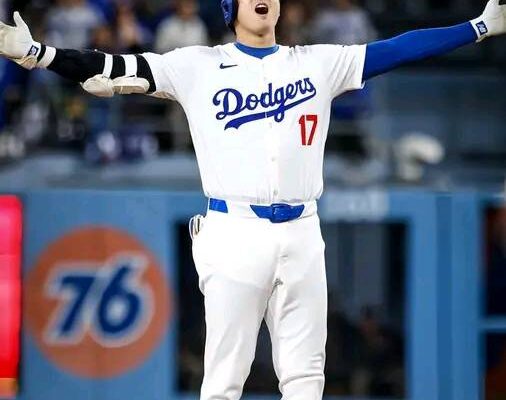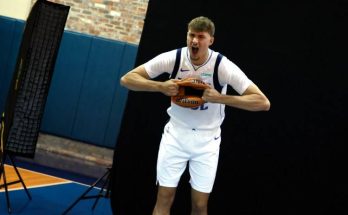In a season already rich with storylines, Shohei Ohtani has once again found a way to capture the spotlight—this time in unexpected fashion. The Los Angeles Dodgers have announced that Ohtani’s much-anticipated live batting practice session has been postponed, sparking a flurry of speculation across the league. But that’s not where the surprises end. In a sudden and dramatic change of plans, Ohtani will now make his long-awaited return to the mound this weekend—not at Busch Stadium in St. Louis as many assumed—but at Petco Park in San Diego, where the Dodgers are set to face their division rivals, the Padres.
This announcement has sent shockwaves through Major League Baseball, not only because it marks Ohtani’s return to pitching—something fans and analysts have been eagerly awaiting all season—but also because of the calculated secrecy and strategic timing surrounding the move. The Dodgers have been careful, even protective, of Ohtani’s progression as he works his way back from injury, shielding him from media noise while quietly managing his workload. Now, with his return made official, all eyes will be on San Diego.
Petco Park, known for its pitcher-friendly dimensions and vibrant West Coast energy, will become the backdrop for what could be one of the most monumental comebacks in recent memory. Fans who expected to see him in action later this summer or in a low-stakes setting now have front-row seats to what promises to be a prime-time baseball event. The change of venue and timing adds an element of theater. It’s not just a start—it’s a statement.
From a baseball operations standpoint, the decision to postpone Ohtani’s live BP and shift his return to an actual game situation at Petco suggests one thing: the Dodgers believe he’s ready. Fully. Not just for tosses off a mound or simulated innings—but for the real deal. Live hitters. Real game speed. Lights on. Cameras rolling. And with the Padres being both a formidable opponent and a media-heavy team in their own right, the Dodgers clearly see value in making this moment big, meaningful, and impactful.
There’s also a psychological layer at play. The Dodgers have always understood that with Ohtani comes not just skill but spectacle. The return of a player like Shohei isn’t just a baseball move—it’s an event. And what better place to stage such a return than a venue like Petco Park, where Dodgers fans travel in droves and media coverage is guaranteed to be intense?
Ohtani’s own mental and physical preparation for this moment cannot be overstated. He’s approached his rehab with quiet intensity, staying locked in behind the scenes while delivering jaw-dropping performances at the plate. His offensive numbers have not dipped. If anything, they’ve soared—showcasing his continued excellence as a designated hitter. But everyone has been wondering the same thing: when will the second half of the two-way marvel return? That question now has an answer.
Even in postponing the live BP, it’s clear this decision was a carefully curated part of his progression. Ohtani has been playing long toss. He’s been working with the Dodgers’ elite medical and performance staff. He’s gone through flat-ground drills, bullpen sessions, and internal pitch simulations. Every box has been checked. Every metric has been met. So rather than wait and ease into things, the Dodgers are pushing go. And they’re doing it on their terms.
For San Diego, this development adds an electrifying wrinkle to an already high-stakes matchup. The Padres and Dodgers have built one of the most intense rivalries in baseball, with Petco Park often feeling like a battleground of playoff energy even in the regular season. And now, Shohei Ohtani, arguably the most talked-about player in the sport, will step onto that mound under the lights, against one of the league’s most aggressive lineups.
What can we expect from him?
If past is prologue, even a returning Ohtani—possibly on a limited pitch count—has the potential to dominate. He won’t need to be perfect. He just needs to show flashes of what made him such a force on the mound in previous seasons. The velocity. The splitter. The sharp slider that breaks late and freezes hitters. Fans should expect a measured approach: likely three to four innings, with efficiency and strike-throwing as the focus. But if he gets into a groove, if the adrenaline kicks in, we might see something truly spectacular.
The Dodgers will, of course, be cautious. They’ve come too far, invested too much, and protected him too carefully to risk re-injury. But make no mistake—Ohtani would not be taking the mound unless he felt completely ready. His standards are too high, and his competitiveness too fierce, to rush back for show. This return is about reclaiming his identity as a two-way player. It’s about reestablishing the balance that makes him one of the most extraordinary athletes of our generation.
What does this mean for the rest of the Dodgers’ season?
It means everything.
With Ohtani back in the pitching rotation—even on a reduced schedule—the Dodgers gain a weapon that other teams simply don’t have. A left-handed flamethrower with elite stuff, coupled with a bat that leads the league in slugging. It’s a double-barrel advantage that no team can match. It also lengthens the rotation and allows for flexibility in how the team manages other arms. In a postseason series, having Ohtani able to contribute on both sides of the ball changes strategy. It changes everything.
It also impacts morale. Having your star player return to full form sends a message to the locker room: we’re all-in. The front office believes. The medical staff believes. Shohei believes. And so, the team rallies. They play sharper. They play faster. That kind of boost cannot be measured solely in wins and losses—it’s about chemistry, energy, and belief.
And let’s not ignore what this means to the fans.
For those who’ve waited patiently all year, who’ve tuned in every night hoping for updates, this is the reward. Ohtani on the mound again isn’t just a baseball moment—it’s a fan celebration. Social media will erupt. Stadiums will buzz. Kids will grab gloves and mimic his windup in the backyard. The magic is back. The dream of seeing someone pitch and hit at an elite level in the same game is alive and well.
For Ohtani personally, this is more than just a scheduled start. It’s a resurrection of his full identity. He’s never wanted to be boxed in as just a hitter. His heart is on the mound. That’s where he believes he makes the biggest impact. And now, after months of healing, waiting, training, and working, he gets to do what only he can do: dominate from both sides of the game.
There’s also poetic symmetry in the setting. Petco Park, a jewel of a stadium along the San Diego waterfront, will now host a return that feels more like a coronation. It’s not just about defeating an opponent—it’s about Ohtani defeating doubt. Defeating time. Defeating everything that stood in the way of this moment. And when he takes that mound, with a city watching and a league holding its breath, the noise will fade. The criticism will fall away. All that will remain is greatness.
Shohei Ohtani is back on the mound. Not at Busch Stadium. Not in batting practice. But in a real game. Under real lights. Against real hitters. At Petco Park, where rivalries are sharp and expectations are sky-high. And in true Ohtani fashion, the unexpected has become the unforgettable.
Welcome back to the full Shohei experience.



